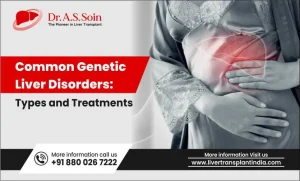Rare liver diseases can arise from a variety of factors and affect only a small segment of the population. Typically stemming from genetic anomalies, these conditions pose significant challenges for individuals and their families, primarily due to difficulties in identifying the disorders and effectively managing them with therapies. In India, a notable number of individuals grapple with rare liver disorders, necessitating specialized care and attention. Fortunately, the expertise of exceptional surgeons like Dr. A.S. Soin enables the effective diagnosis and provision of proper care to those affected.
Table of Contents
ToggleWilson’s Disease
Wilson’s disease, impacting approximately 1 in 30,000 to 40,000 individuals globally, originates from a genetic abnormality leading to copper accumulation, primarily in the liver. While symptoms in other affected organs may go unnoticed, liver issues often present first, particularly in young individuals. Neurological or psychiatric symptoms can also manifest in adults, complicating diagnosis, which may be mistaken for other conditions like viral hepatitis or psychiatric disorders. With approximately 1 in 90 individuals carrying the Wilson disease gene, early detection and management are crucial to mitigate complications such as chronic liver disease and cirrhosis.
Alpha 1 Antitrypsin Deficiency (AATD)
Commonly known as genetic emphysema, Alpha 1 Antitrypsin deficiency is a rare liver disease typically observed in young adults. Research in India has shown varying prevalence rates, with a study indicating suspicion of AATD in approximately 7.8% of children diagnosed with chronic liver disease and neonatal cholestasis. However, prevalence appears lower in India compared to other regions. Individuals with susceptible genes typically exhibit symptoms during adulthood, as mutations in the SERPINA1 gene result in decreased levels of alpha-1 antitrypsin proteins, leading to potential lung tissue damage and liver complications such as cirrhosis.
Alagille Syndrome (ALGS)
Alagille Syndrome, a rare condition stemming from genetic abnormalities, affects multiple organs including the liver, heart, skeleton, eyes, and kidneys. Unlike other rare liver diseases, ALGS presents during infancy and affects both sexes equally across all regions and ethnicities. The syndrome arises from bile duct abnormalities, impairing bile transportation from the liver to the small intestine and resulting in bile accumulation, leading to symptoms like jaundice, itching, and potential liver failure. Early identification and multidisciplinary care are essential for better prognoses in ALGS patients.
Primary Sclerosing Cholangitis (PSC)
Primarily observed in individuals with inflammatory bowel diseases (IBDs), primary sclerosing cholangitis obstructs bile flow due to inflammation resulting from IBD. While its exact prevalence remains unknown, records suggest a significant rise in PSC cases, making it the fifth leading cause of liver transplantation in the United States. Management involves addressing symptoms, monitoring liver function, and considering transplantation in severe cases, highlighting the importance of increased awareness and research efforts.
Primary Biliary Cholangitis (PBC)
Formerly known as primary biliary cirrhosis, PBC is a chronic condition characterized by the progressive destruction of bile ducts within the liver. Diagnosis typically occurs between ages 30 and 60, with varying prevalence rates across different regions. While no cure exists, treatment focuses on slowing disease progression and managing symptoms with medications like UDCA. In severe cases leading to liver damage or cirrhosis, transplantation may be necessary to improve survival rates.
Hereditary Hemochromatosis (HH)
Hereditary hemochromatosis, characterized by excess iron absorption, poses risks including liver disorders, heart problems, and diabetes due to iron accumulation in organs. Treatment involves regular blood removal to normalize iron levels. Although rare in India, reports indicate its occurrence is due to HJV gene mutations, contributing to primary hemochromatosis. Early detection and management are crucial to prevent complications.
Conclusion
In India, individuals with rare liver diseases face significant challenges, necessitating advanced research, genetic testing, public awareness, and access to specialized healthcare. Distinguished surgeons like Dr. A.S. Soin play a vital role in providing expert care and innovative treatment solutions, contributing to notable progress in addressing these complex conditions. Dr. Soin’s commitment to excellence, compassionate patient care, and advancements in surgical procedures and medical technologies offer hope and improved outcomes for those affected by rare liver diseases.








